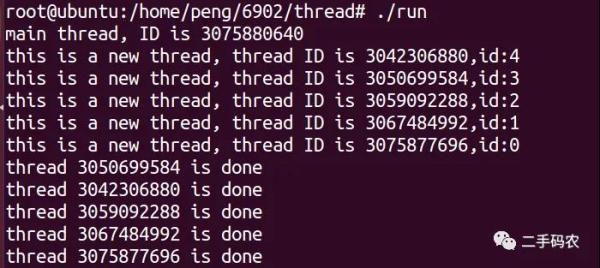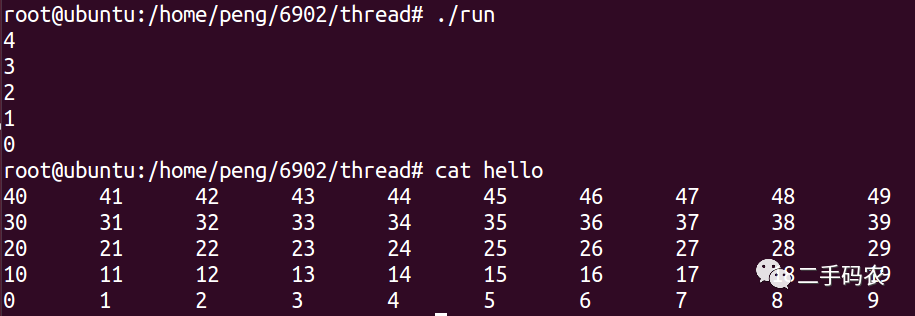您好,登錄后才能下訂單哦!
您好,登錄后才能下訂單哦!
本篇內容介紹了“Linux線程互斥鎖的概念”的有關知識,在實際案例的操作過程中,不少人都會遇到這樣的困境,接下來就讓小編帶領大家學習一下如何處理這些情況吧!希望大家仔細閱讀,能夠學有所成!
在編程中,引入了對象互斥鎖的概念,來保證共享數據操作的完整性。每個對象都對應于一個可稱為" 互斥鎖" 的標記,這個標記用來保證在任一時刻,只能有一個線程訪問該對象。
Linux實現的互斥鎖機制包括POSIX互斥鎖和內核互斥鎖,本文主要講POSIX互斥鎖,即線程間互斥鎖。
“ 信號量用在多線程多任務同步的,一個線程完成了某一個動作就通過信號量告訴別的線程,別的線程再進行某些動作(大家都在sem_wait的時候,就阻塞在 那里)。而互斥鎖是用在多線程多任務互斥的,一個線程占用了某一個資源,那么別的線程就無法訪問,直到這個線程unlock,其他的線程才開始可以利用這 個資源。比如對全局變量的訪問,有時要加鎖,操作完了,在解鎖。有的時候鎖和信號量會同時使用的”
也就是說,信號量不一定是鎖定某一個資源,而是 流程上的概念,比如:有A,B兩個線程,B線程要等A線程完成某一任務以后再進行自己下面的步驟,這個任務并不一定是鎖定某一資源,還可以是進行一些計算 或者數據處理之類。而線程互斥量則是“鎖住某一資源”的概念,在鎖定期間內,其他線程無法對被保護的數據進行操作。在有些情況下兩者可以互換。
兩者之間的區別:
作用域
信號量 : 進程間或線程間(linux僅線程間)
互斥鎖 : 線程間
上鎖時
信號量 : 只要信號量的value大于0,其他線程就可以sem_wait成功,成功后信號量的value減一。若value值不大于0,則sem_wait阻塞,直到sem_post釋放后value值加一。一句話,信號量的value>=0 。
互斥鎖 : 只要被鎖住,其他任何線程都不可以訪問被保護的資源。如果沒有鎖,獲得資源成功,否則進行阻塞等待資源可用。一句話,線程互斥鎖的vlaue可以為負數 。
多線程
線程是計算機中獨立運行的最小單位,運行時占用很少的系統資源。與多進程相比,多進程具有多進程不具備的一些優點,其最重要的是:對于多線程來說,其能夠比多進程更加節省資源。
線程創建
在Linux中,新建的線程并不是在原先的進程中,而是系統通過一個系統調用clone()。該系統copy了一個和原先進程完全一樣的進程,并在這個進程中執行線程函數。
在Linux中,通過函數pthread_create()函數實現線程的創建:
pthread_create()
int pthread_create(pthread_t *thread, const pthread_attr_t *attr,void *(*st
其中:
thread表示的是一個pthread_t類型的指針;
attr用于指定線程的一些屬性;
start_routine表示的是一個函數指針,該函數是線程調用函數;
arg表示的是傳遞給線程調用函數的參數。
當線程創建成功時,函數pthread_create()返回0,若返回值不為0則表示創建線程失敗。對于線程的屬性,則在結構體pthread_attr_t中定義。
線程創建的過程如下所示:
#include <stdio.h> #include <pthread.h> #include <unistd.h> #include <malloc.h> void* thread(void *id){ pthread_t newthid; newthid = pthread_self(); printf("this is a new thread, thread ID is %u\n", newthid); return NULL; } int main(){ int num_thread = 5; pthread_t *pt = (pthread_t *)malloc(sizeof(pthread_t) * num_thread); printf("main thread, ID is %u\n", pthread_self()); for (int i = 0; i < num_thread; i++){ if (pthread_create(&pt[i], NULL, thread, NULL) != 0){ printf("thread create failed!\n"); return 1; } } sleep(2); free(pt); return 0; }在上述代碼中,使用到了pthread_self()函數,該函數的作用是獲取本線程的線程ID。在主函數中的sleep()用于將主進程處于等待狀態,以讓線程執行完成。最終的執行效果如下所示:

那么,如何利用arg向子線程傳遞參數呢?其具體的實現如下所示:
#include <stdio.h> #include <pthread.h> #include <unistd.h> #include <malloc.h> void* thread(void *id){ pthread_t newthid; newthid = pthread_self(); int num = *(int *)id; printf("this is a new thread, thread ID is %u,id:%d\n", newthid, num); return NULL; } int main(){ //pthread_t thid; int num_thread = 5; pthread_t *pt = (pthread_t *)malloc(sizeof(pthread_t) * num_thread); int * id = (int *)malloc(sizeof(int) * num_thread); printf("main thread, ID is %u\n", pthread_self()); for (int i = 0; i < num_thread; i++){ id[i] = i; if (pthread_create(&pt[i], NULL, thread, &id[i]) != 0){ printf("thread create failed!\n"); return 1; } } sleep(2); free(pt); free(id); return 0; }其最終的執行效果如下圖所示:

如果在主進程提前結束,會出現什么情況呢?如下述的代碼:
#include <stdio.h> #include <pthread.h> #include <unistd.h> #include <malloc.h> void* thread(void *id){ pthread_t newthid; newthid = pthread_self(); int num = *(int *)id; printf("this is a new thread, thread ID is %u,id:%d\n", newthid, num); sleep(2); printf("thread %u is done!\n", newthid); return NULL; } int main(){ //pthread_t thid; int num_thread = 5; pthread_t *pt = (pthread_t *)malloc(sizeof(pthread_t) * num_thread); int * id = (int *)malloc(sizeof(int) * num_thread); printf("main thread, ID is %u\n", pthread_self()); for (int i = 0; i < num_thread; i++){ id[i] = i; if (pthread_create(&pt[i], NULL, thread, &id[i]) != 0){ printf("thread create failed!\n"); return 1; } } //sleep(2); free(pt); free(id); return 0; }此時,主進程提前結束,進程會將資源回收,此時,線程都將退出執行,運行結果如下所示:

線程掛起
在上述的實現過程中,為了使得主線程能夠等待每一個子線程執行完成后再退出,使用了free()函數,在Linux的多線程中,也可以使用pthread_join()函數用于等待其他線程,函數的具體形式為:
int pthread_join(pthread_t thread, void **retval);
函數pthread_join()用來等待一個線程的結束,其調用這將被掛起。
一個線程僅允許一個線程使用pthread_join()等待它的終止。
如需要在主線程中等待每一個子線程的結束,如下述代碼所示:
#include <stdio.h> #include <pthread.h> #include <unistd.h> #include <malloc.h> void* thread(void *id){ pthread_t newthid; newthid = pthread_self(); int num = *(int *)id; printf("this is a new thread, thread ID is %u,id:%d\n", newthid, num); printf("thread %u is done\n", newthid); return NULL; } int main(){ int num_thread = 5; pthread_t *pt = (pthread_t *)malloc(sizeof(pthread_t) * num_thread); int * id = (int *)malloc(sizeof(int) * num_thread); printf("main thread, ID is %u\n", pthread_self()); for (int i = 0; i < num_thread; i++){ id[i] = i; if (pthread_create(&pt[i], NULL, thread, &id[i]) != 0){ printf("thread create failed!\n"); return 1; } } for (int i = 0; i < num_thread; i++){ pthread_join(pt[i], NULL); } free(pt); free(id); return 0; }最終的執行效果如下所示:

注:在編譯的時候需要鏈接libpthread.a:
g++ xx.c -lpthread -o xx
互斥鎖mutex
多線程的問題引入
多線程的最大的特點是資源的共享,但是,當多個線程同時去操作(同時去改變)一個臨界資源時,會破壞臨界資源。如利用多線程同時寫一個文件:
#include <stdio.h> #include <pthread.h> #include <malloc.h> const char filename[] = "hello"; void* thread(void *id){ int num = *(int *)id; // 寫文件的操作 FILE *fp = fopen(filename, "a+"); int start = *((int *)id); int end = start + 1; setbuf(fp, NULL);// 設置緩沖區的大小 fprintf(stdout, "%d\n", start); for (int i = (start * 10); i < (end * 10); i ++){ fprintf(fp, "%d\t", i); } fprintf(fp, "\n"); fclose(fp); return NULL; } int main(){ int num_thread = 5; pthread_t *pt = (pthread_t *)malloc(sizeof(pthread_t) * num_thread); int * id = (int *)malloc(sizeof(int) * num_thread); for (int i = 0; i < num_thread; i++){ id[i] = i; if (pthread_create(&pt[i], NULL, thread, &id[i]) != 0){ printf("thread create failed!\n"); return 1; } } for (int i = 0; i < num_thread; i++){ pthread_join(pt[i], NULL); } // 釋放資源 free(pt); free(id); return 0; }執行以上的代碼,我們會發現,得到的結果是混亂的,出現上述的最主要的原因是,我們在編寫多線程代碼的過程中,每一個線程都嘗試去寫同一個文件,這樣便出現了上述的問題,這便是共享資源的同步問題,在Linux編程中,線程同步的處理方法包括:信號量,互斥鎖和條件變量。
互斥鎖
互斥鎖是通過鎖的機制來實現線程間的同步問題。互斥鎖的基本流程為:
初始化一個互斥鎖:pthread_mutex_init()函數
加鎖:pthread_mutex_lock()函數或者pthread_mutex_trylock()函數
對共享資源的操作
解鎖:pthread_mutex_unlock()函數
注銷互斥鎖:pthread_mutex_destory()函數
其中,在加鎖過程中,pthread_mutex_lock()函數和pthread_mutex_trylock()函數的過程略有不同:
當使用pthread_mutex_lock()函數進行加鎖時,若此時已經被鎖,則嘗試加鎖的線程會被阻塞,直到互斥鎖被其他線程釋放,當pthread_mutex_lock()函數有返回值時,說明加鎖成功;
而使用pthread_mutex_trylock()函數進行加鎖時,若此時已經被鎖,則會返回EBUSY的錯誤碼。
同時,解鎖的過程中,也需要滿足兩個條件:
解鎖前,互斥鎖必須處于鎖定狀態;
必須由加鎖的線程進行解鎖。
當互斥鎖使用完成后,必須進行清除。
有了以上的準備,我們重新實現上述的多線程寫操作,其實現代碼如下所示:
#include <stdio.h> #include <pthread.h> #include <malloc.h> pthread_mutex_t mutex; const char filename[] = "hello"; void* thread(void *id){ int num = *(int *)id; // 加鎖 if (pthread_mutex_lock(&mutex) != 0){ fprintf(stdout, "lock error!\n"); } // 寫文件的操作 FILE *fp = fopen(filename, "a+"); int start = *((int *)id); int end = start + 1; setbuf(fp, NULL);// 設置緩沖區的大小 fprintf(stdout, "%d\n", start); for (int i = (start * 10); i < (end * 10); i ++){ fprintf(fp, "%d\t", i); } fprintf(fp, "\n"); fclose(fp); // 解鎖 pthread_mutex_unlock(&mutex); return NULL; } int main(){ int num_thread = 5; pthread_t *pt = (pthread_t *)malloc(sizeof(pthread_t) * num_thread); int * id = (int *)malloc(sizeof(int) * num_thread); // 初始化互斥鎖 if (pthread_mutex_init(&mutex, NULL) != 0){ // 互斥鎖初始化失敗 free(pt); free(id); return 1; } for (int i = 0; i < num_thread; i++){ id[i] = i; if (pthread_create(&pt[i], NULL, thread, &id[i]) != 0){ printf("thread create failed!\n"); return 1; } } for (int i = 0; i < num_thread; i++){ pthread_join(pt[i], NULL); } pthread_mutex_destroy(&mutex); // 釋放資源 free(pt); free(id); return 0; }最終的結果為:

“Linux線程互斥鎖的概念”的內容就介紹到這里了,感謝大家的閱讀。如果想了解更多行業相關的知識可以關注億速云網站,小編將為大家輸出更多高質量的實用文章!
免責聲明:本站發布的內容(圖片、視頻和文字)以原創、轉載和分享為主,文章觀點不代表本網站立場,如果涉及侵權請聯系站長郵箱:is@yisu.com進行舉報,并提供相關證據,一經查實,將立刻刪除涉嫌侵權內容。